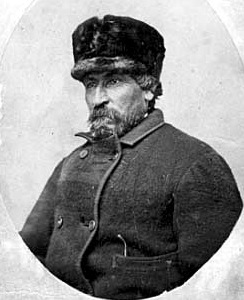Pierre Bottineau facts for kids
Pierre Bottineau (born January 1, 1817 – died July 26, 1895) was an important frontiersman in Minnesota. He was sometimes called the "Kit Carson of the Northwest" because he was so skilled at exploring and settling new lands.
Pierre Bottineau played a big part in the history and growth of both Minnesota and North Dakota. He was a talented surveyor, which means he helped map out land. His work led to the founding of many cities across these states. Some of these cities include Osseo, Minnesota and Maple Grove, Minnesota near the Twin Cities, as well as Breckenridge, Minnesota and Wahpeton, North Dakota along the Red River of the North.
He also helped start Orono Village in Sherburne County, Minnesota (which later became part of Elk River, Minnesota). He also helped found the growing city of St. Anthony, which later joined with Minneapolis. Pierre was also known as a great diplomat and translator, earning him the nickname "The Walking Peace Pipe." He helped create many agreements with Native American tribes. His obituary said he could speak French, English, Dakota, Ojibwe, Cree, Mandan, and Winnebago.
Contents
Early Life and Background
Pierre Bottineau was born in a hunting camp near Grand Forks, North Dakota. This camp was on a trail used by buffalo. His father, Charles Bottineau, was French-Canadian. His mother, Marguerite Macheyquayzaince Ahdicksongab, was known as "Clear Sky Woman." She was half Dakota and half Ojibwe from the Lake of the Woods band. She was also the sister of the Pembina Ojibwe chief, Misko-Makwa, or Red Bear.
A Key Figure in American Expansion
Even though Pierre was born in what was technically United States land, the British controlled the Upper Mississippi Valley during the War of 1812. After the 1815 Treaty of Ghent, the land officially returned to the U.S. However, British and Canadian traders, along with Native American tribes, still held most of the power there.
The U.S. government relied on people like Pierre Bottineau to help settle the land. He helped establish American control over these areas. Pierre was of mixed heritage, known as Métis. While many Métis people faced challenges, Pierre's important work and adventures made him famous in his time. When he retired, the United States Congress gave him a pension of $50 a month. He passed away in Red Lake Falls, Minnesota when he was 78 years old.
Legacy and Namesakes
Pierre Bottineau's name lives on in many places. Bottineau County, North Dakota, and its main town, Bottineau, North Dakota, are named after him. The Pierre Bottineau Library and Bottineau Park in Minneapolis also carry his name. In Hennepin County, Minnesota, you can find Bottineau Blvd. There have also been plans for a light rail line in Minneapolis called the Bottineau LRT.
Images for kids
-
Bottineau's 1854 house, preserved in Maple Grove, Minnesota



